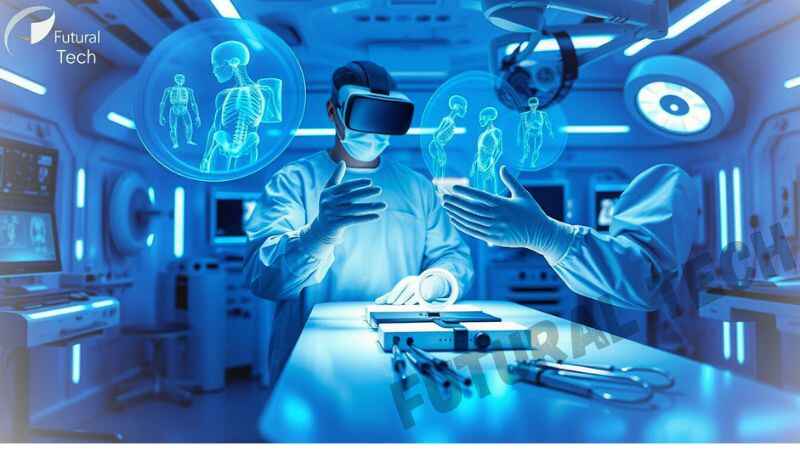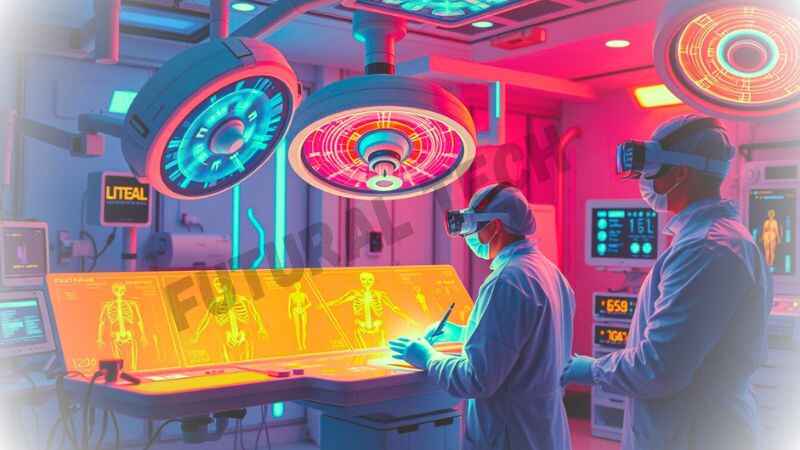What is the future of VR in surgery?
By- Raj 17th-Oct-2024

Gone are the days when the evolution of surgery in virtual reality (VR) was slow. VR is a blend of the gadgets we use in healthcare. The subject is why surgeons are using their VR glasses to participate in procedures, rather than only as machines for practice. This article will explore the alterations that VR will specifically bring about in the surgical field.
Key Takeaways
- VR has completely changed the way realistic surgical scenarios are now practiced and surgeons are assessed for their skills.
- At the same time, surgical patient education is also being improved by patients watching their controlled operations using Augmented Reality (AR) technology.
- The visualization potential has been increased by the use of life-like 3D models made of VR and AR technologies before the actual surgery.
- Through telesurgery, procedures can be performed from a distance, and specialists can provide support from anywhere in the world.
- The time has come for VR as a means of managing pain rather than just being used for entertainment. Not only that, it also has the potential to improve the recovery period.
Introduction to VR in Surgery
Venture capital for the healthcare industry is transforming with the rise of virtual reality (VR) in surgery. It is used abundantly to simulate surgeries, and in the process, it also makes planning of surgeries easier. This novel technology is dramatically altering the experience of healthcare professionals with their patients.
The Benefits of VR-Guided Surgical Procedures
The doctors, in fact, are now able to undergo a kind of virtual surgery by operating in an artificial world that is virtually the same as what they would have operated in their own real body. They will perform the operations with increased accuracy and also schedule them perfectly. Consequently, surgery and patient care will be improved accordingly.
Moreover, VR helps make the whole process more transparent by cutting down on errors and expediting the recovery. It's all about getting patients the best care possible.
Advantages of VR in Surgery
- Enhanced visualization and successful plan development surgery
- The reduction of the occurrence of errors and complications
- Faster recovery periods for the patients
- Better surgical training and skill development
“VR has the potential to revolutionize the way we approach surgery, from training to execution. By immersing our surgeons in virtual environments, we can help them hone their skills and provide better care for our patients.”
The prospects of VR in surgery look bright. What is the future of VR in surgery? VR is revolutionizing the healthcare sector; from 1st choice healthcare paragould ar to sama healthcare el dorado ar. It is evident how beneficial VR is in surgeries.
With the healthcare industry's ongoing what is the future of VR acceptance? VR is taking over as one of the surgery's symbols. Deviating from the normal teaching and learning procedures, it is more interactive and appealing. From implementing AR in teaching to AR tools for teachers and AR for student engagement, VR is making a big impact.
What is the future of VR in surgery?
The future of virtual reality (VR) in surgery is highly encouraging. VR is a technology that brings transformations in the sphere of healthcare. It eases the way for the surgeries that are performed and the safety norms that are ensured for the health.
VR is of great significance in the realm of doctors’ practice and surgery. It allows them to be better at their work, which results in better patient care and results.
What we meet in VR that is known to us of the sight systems is VR-guided surgery. Suffering from the phobia of the surgery is far from being easy. Virtual-reality simulation allows the patient to have an experience as close as possible to the surgery but without feeling guilty of annoying the doctor or something like that.
VR Enhancements in Surgical Procedures
Along with that, VR (virtual reality) used in surgical operations is also making the surgeries become better rapidly. They can look through the visible anatomy to identify the location of the tumor and thus can remove the cankers easily and accurately which leads to quick recovery of the patients.
Moreover, virtual reality (VR) is also utilized in helping patients receive vital information about their health. They can use it to check their internal body parts. Normally this helps them face their health issues consciously leading to better health decisions.
| Feature | Benefit | ||
|
|
||
|
|
||
|
|
Challenges in Adopting VR in Surgery
However, the use of VR in surgery comes with certain problems. Addressing technical, cost, and legal aspects is the job of healthcare providers. Still, the practice takes priority over the issues.
Immersive Surgical Training with VR
Not only is VR technology indispensable, but the confrontation of medicine that is medicine itself has already changed and will change even faster in the future, saving new and more lives. The implementation of VR in education has brought about critical solutions like the possibility of every student taking programs or valuable lessons with the help of technology. Employers will remain resolute in their decision and keep in mind the implemented technology as their and the educational welfare.
VR Simulations for Skill Development
The use of VR in the process of surgical training is tremendously transforming surgeries in the future. These models are very similar to realistic surgeries so they imply the participation of different members together. Surgeons are taught and helped by the models electrically and by telemedicine as well.
Enhancing Patient Education with VR
Besides the revolution in the way healthcare is provided, VR also causes patients to get acquainted with more state-of-the-art ways to be healthy. By utilizing VR, doctors can demonstrate to patients their anatomy and planned surgeries. Thus, this aids the patients in making wiser choices and feeling more a part of their care.
As VR gets integrated into surgery, we will notice that there will be increased applications. It will be the solution to surgical planning and will connect doctors across your patients in a virtual space. The potential of VR in surgery is limitless.
| Benefits of Telesurgery | Challenges of Telesurgery |
|---|---|
|
|
Telesurgery and remote collaboration are transforming the way we deliver healthcare, breaking down geographical barriers and providing patients with access to the best medical expertise, regardless of their location.
Augmented Reality in the Operating Room
AR for sure is one of the major contributors to the surgical modernization movement. AR makes the surgeon's sight or field of vision smarter and more ideal. They get the possibility to add visual information to the real world such as, for instance, the patient's body map. And so they can do their work focused and with much less human errors. Also, it has been suggested that it could help the recovery of patients by AR. Nevertheless, both the doctor and the patient must go through a learning process to adapt to this new AR technology.
Benefits of AR in Surgery
Faster and more accurate treatment is offered by AR in that doctors can accurately identify what is wrong with the patient. They have the capability of viewing 3D models or layers of digital information arranged on the person's body. This helps them to visualize the affected part of the body, find the crucial areas, and better mold the solution to the problem at hand. Especially it is in the area of the body parts that need to be very accurate and related to the use of small incisions.
Applying technologies brings into being healthcare systems where it is easy to greet the dawn of the AR era. We start to see AR technology take off in the surgery theaters. Kicking off with some early adopters of the technology in the medical space such as the 1st choice Healthcare Paragould AR and Sama Healthcare El Dorado AR, the healthcare industry is joining the ranks as the sheer prospects of AR are revealed through the technology.

Virtual Reality for Surgical Planning
The future of what is the future of VR in surgery? appears to be rosier than in the present. Futuraltch and Futuraltchx were among the front-line companies that made notable advancements in the area of virtual reality (VR). The technology now allows surgeons to see a patient's 3D anatomy in real-time during procedures. This, along with the telepresence technologies, can allow surgeons to plan surgery without being in the operating room. Surgeons can preview each step of their approach before they even begin. And even more importantly, they can better visualize the results of the procedures they will take.
VR Applications in Surgical Procedures
The present pace of innovations is quickly turning this surgery of the future into surgery of the present. And it makes all sense to embrace and utilize the next generation of augmented reality, virtual reality, and AI. There are sure to be many more types of visual and active relationships between the doctor and the patient in the future.
Conclusion
In conclusion, the integration of virtual reality and augmented reality in surgical practices is setting a new standard in the healthcare industry. By enhancing surgical training, patient education, and recovery processes, VR is transforming how surgeries are performed and experienced. The future holds exciting possibilities as technology continues to evolve, ensuring better outcomes for both surgeons and patients alike.
Healthcare providers must keep pace with these advancements and leverage them to improve surgical outcomes, patient satisfaction, and overall healthcare quality.












